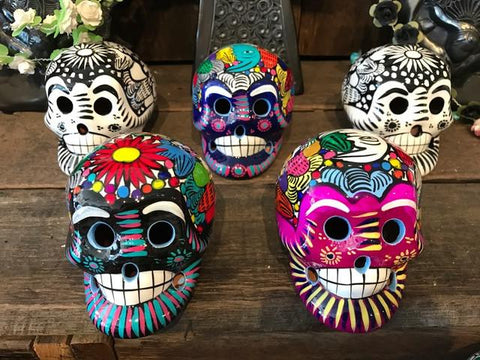What does the Sugar Skull Represent
Sugar skulls are beautifully decorated and colorful skulls that are seen everywhere in Día de los Muertos celebrations. They are usually placed on altars, but people also decorate their own faces to look like sugar skulls. What exactly is the history behind them and what do they represent?

Lately, I’ve noticed the growing popularity of skulls and sugar skulls in Western culture – you can find them in all shapes and sizes plastered all over t-shirts, as ornaments in jewelry, illustrated in graffiti or tattooed on someone’s arm. Yes, skulls are definitely gaining mainstream popularity but have you ever though about the origins of sugar skulls or what exactly do they represent? I’m thinking not, as I highly doubt that half the people who have them printed on a piece of clothing have ever bothered to do some simple research into this fascinating subject.
Within the Western culture, skulls usually depict the dark, macabre and gruesome death. However sugar skulls’ origin (or calaveras de azucar) springs from Mexico. Day of the Dead (Dia de los Muertos) is a Mexican holiday, celebrated on the 1st and 2nd November in connection with the Catholic holidays of All Saint’s Day and All Hollow’s Day. The festivities start at midnight on the 31st October. Sugar skulls are often used to decorate the gravestones of the deceased. The reason they are called “sugar skulls” is because the authentic sugar skulls were made out of clay molded sugar, decorated with feathers, colored beads, foils and icing. These sugar skulls are very colorful and whimsical, not scary at all. The name of the deceased relative could be written on the skull’s forehead and then put on the altar, accompanied by marigolds (the marigold is perceived as the flower of the dead), candles and maybe even the deceased’s favorite food and beverage in order to encourage and guide him back to earth.
Smaller skulls are placed on the offrenda (altar) on November 1st, representing the children who have passed away. Larger, more detailed ones would then replace them on the 2nd November, which represent the adults. The departed are believed to return home to enjoy the offerings on the altar.
Read more: https://crueldazeofsummer.wordpress.com/2013/08/12/sugar-skulls-status-in-popular-culture-what-is-their-meaning-and-where-do-they-originate-from/
